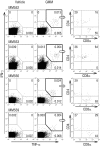Major T cell response to a mycolyl glycolipid is mediated by CD1c molecules in rhesus macaques
- PMID: 23132493
- PMCID: PMC3536160
- DOI: 10.1128/IAI.00871-12
Major T cell response to a mycolyl glycolipid is mediated by CD1c molecules in rhesus macaques
Abstract
Human CD1b molecules contain a maze of hydrophobic pockets and a tunnel capable of accommodating the unusually long, branched acyl chain of mycolic acids, an essential fatty acid component of the cell wall of mycobacteria. It has been accepted that CD1b-bound mycolic acids constitute a scaffold for mycolate-containing (glyco)lipids stimulating CD1b-restricted T cells. Remarkable homology in amino acid sequence is observed between human and monkey CD1b molecules, and indeed, monkey CD1b molecules are able to bind glucose monomycolate (GMM), a glucosylated species of mycolic acids, and present it to specific human T cells in vitro. Nevertheless, we found, unexpectedly, that Mycobacterium bovis bacillus Calmette-Guerin (BCG)-vaccinated monkeys exhibited GMM-specific T cell responses that were restricted by CD1c rather than CD1b molecules. GMM-specific, CD1c-restricted T cells were detected in the circulation of all 4 rhesus macaque monkeys tested after but not before vaccination with BCG. The circulating GMM-specific T cells were detected broadly in both CD4(+) and CD8(+) cell populations, and upon antigenic stimulation, a majority of the GMM-specific T cells produced both gamma interferon (IFN-γ) and tumor necrosis factor alpha (TNF-α), two major host protective cytokines functioning against infection with mycobacteria. Furthermore, the GMM-specific T cells were able to extravasate and approach the site of infection where CD1c(+) cells accumulated. These observations indicate a previously inconceivable role for primate CD1c molecules in eliciting T cell responses to mycolate-containing antigens.
Figures




References
-
- Beckman EM, Porcelli SA, Morita CT, Behar SM, Furlong ST, Brenner MB. 1994. Recognition of a lipid antigen by CD1-restricted alpha beta+ T cells. Nature 372:691–694 - PubMed
-
- Moody DB, Reinhold BB, Guy MR, Beckman EM, Frederique DE, Furlong ST, Ye S, Reinhold VN, Sieling PA, Modlin RL, Besra GS, Porcelli SA. 1997. Structural requirements for glycolipid antigen recognition by CD1b-restricted T cells. Science 278:283–286 - PubMed
-
- Batuwangala T, Shepherd D, Gadola SD, Gibson KJ, Zaccai NR, Fersht AR, Besra GS, Cerundolo V, Jones EY. 2004. The crystal structure of human CD1b with a bound bacterial glycolipid. J. Immunol. 172:2382–2388 - PubMed
-
- Layre E, Collmann A, Bastian M, Mariotti S, Czaplicki J, Prandi J, Mori L, Stenger S, De Libero G, Puzo G, Gilleron M. 2009. Mycolic acids constitute a scaffold for mycobacterial lipid antigens stimulating CD1-restricted T cells. Chem. Biol. 16:82–92 - PubMed
Publication types
MeSH terms
Substances
LinkOut - more resources
Full Text Sources
Medical
Research Materials

